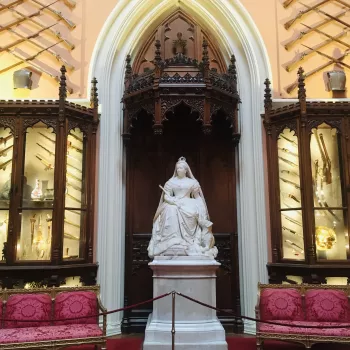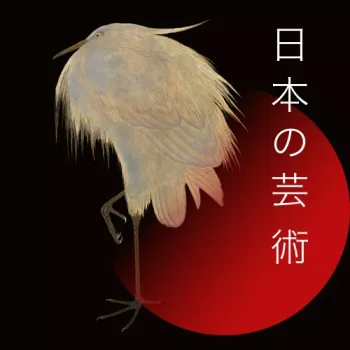Square vessel c.1970-75
Stoneware with 'kaki' (variagated brown) glaze | 22.2 x 17.0 x 16.2 cm (whole object) | RCIN 68402
-
Hamada Shōji was a leading artist–potter of the twentieth century and a pioneer of the Japanese Folk Craft movement, Mingei. The school emerged in reaction to the rapid industrialisation and westernisation of the Taishō period (1912–26), as artists sought to return to rural values and a distinctively national aesthetic. The name is an abbreviation of minshūteki kōgei (‘crafts of the ordinary people’). Central to this tradition is an emphasis on handmade rather than mass-produced objects, created by craftsmen working close to nature.
This thickly potted square vessel is typical of Hamada’s work, which is marked by a solidity of form and generous glaze. Here, his rich kaki (literally ‘persimmon’) glaze is interspersed with mottled and gritty sand-coloured patches, outlined in lively brushstrokes of bluish-green. The overall effect is earthy and spontaneous. An almost identical piece was exhibited at the Pucker Gallery in Boston in 2015 (Into the Present: The Ceramic Art of Tomoo Hamada, Including Works by Shoji and Shinsaku Hamada, Boston, no. H64.) Hamada had experimented with thousands of original glazes made from powdered stone and ash during his early career at the Tokyo Technical College (1913–16) and the Kyoto Municipal Research Institute (1916–19). In 1920, he moved to England to collaborate with the British studio potter Bernard Leach (1887–1979) in St Ives, Cornwall. Their lifelong partnership did much to cement the connection between Mingei and the English Arts and Crafts movement, which shared similar aesthetic and social values.
After his return to Japan in 1924, Hamada established a workshop in the small pottery-making village of Mashiko, 100 km (60 miles) north of Tokyo. The move reflected the Mingei commitment to rural industry and a conviction that artists should operate within small communities. On this pot, Hamada has applied thick pigments according to old Mashiko practice: using a homemade brush fashioned from the long, coarse hair at the back of a dog’s neck. In 1955 he was honoured by the Imperial Government as a ‘Holder of Important Intangible Cultural Properties’ (Ningen Kokuhō or Living National Treasure).
The vessel was presented to Her Majesty The Queen by Prime Minister Miki Takeo during her State Visit to Japan in May 1975. On the same occasion, The Queen gave the emperor and empress a stoneware plate and soft ground etching by Leach.
Text adapted from Chinese and Japanese Works of Art in the Collection of Her Majesty The Queen, Volume II and Japan: Courts and Culture (2020)Provenance
Presented to Queen Elizabeth II by Prime Minister Miki Takeo and his wife during her State Visit to Japan, May 1975
-
Creator(s)
(ceramic artist)(nationality)Acquirer(s)
-
Medium and techniques
Stoneware with 'kaki' (variagated brown) glaze
Measurements
22.2 x 17.0 x 16.2 cm (whole object)
Category
Object type(s)









